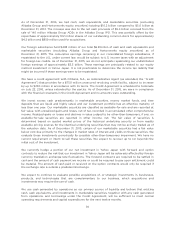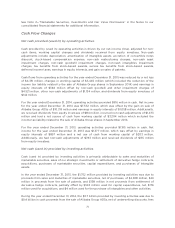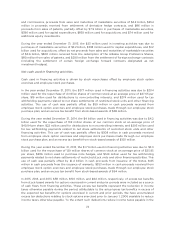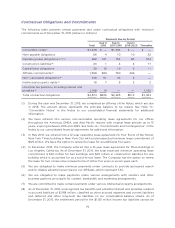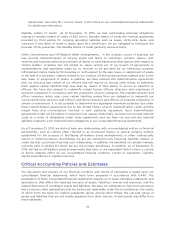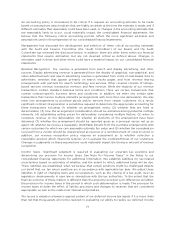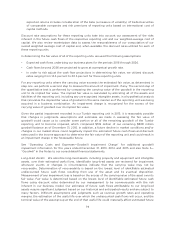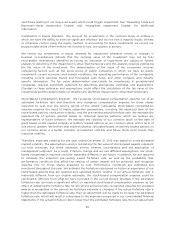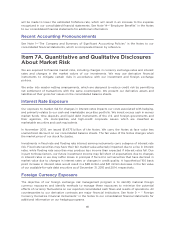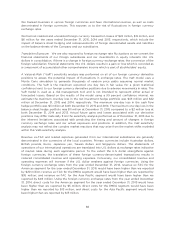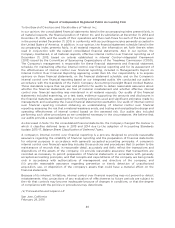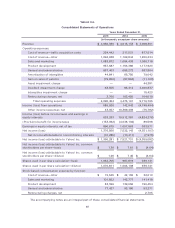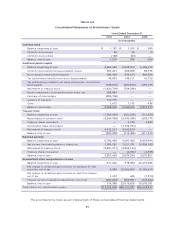Yahoo 2015 Annual Report Download - page 83
Download and view the complete annual report
Please find page 83 of the 2015 Yahoo annual report below. You can navigate through the pages in the report by either clicking on the pages listed below, or by using the keyword search tool below to find specific information within the annual report.expected returns includes consideration of the beta (a measure of volatility) of traded securities
of comparable companies and risk premiums of reporting units based on international cost of
capital methods.
Discount rate assumptions for these reporting units take into account our assessment of the risks
inherent in the future cash flows of the respective reporting unit and our weighted-average cost of
capital. We also review marketplace data to assess the reasonableness of our computation of our
overall weighted average cost of capital and, when available, the discount rates utilized for each of
these reporting units.
In determining the fair value of all of the reporting units, we used the following assumptions:
• Expected cash flows underlying our business plans for the periods 2016 through 2026.
• Cash flows beyond 2026 are projected to grow at a perpetual growth rate.
• In order to risk adjust the cash flow projections in determining fair value, we utilized discount
rates ranging from 14.5 percent to 20.5 percent for these reporting units.
For any reporting units where the carrying value exceeds the estimated fair value, as determined in
step one, we perform a second step to measure the amount of impairment, if any. The second step of
the quantitative test is performed by comparing the carrying value of the goodwill in the reporting
unit to its implied fair value. The implied fair value is calculated by allocating all of the assets and
liabilities of the reporting unit, including any unrecognized intangible assets, in a hypothetical analysis
that calculates the implied fair value of goodwill in the same manner as if the reporting unit was being
acquired in a business combination. An impairment charge is recognized for the excess of the
carrying value of goodwill over its implied fair value.
Given the partial impairment recorded in our Tumblr reporting unit in 2015, it is reasonably possible
that changes in judgments, assumptions and estimates we made in assessing the fair value of
goodwill could cause us to consider some portion or all of the remaining goodwill of the Tumblr
reporting unit to become impaired, which comprised $519 million of our remaining $808 million
goodwill balance as of December 31, 2015. In addition, a future decline in market conditions and/or
changes in our market share could negatively impact the estimated future cash flows and discount
rates used in the income approach to determine the fair value of the reporting unit and could result in
an impairment charge in the foreseeable future.
See “Operating Costs and Expenses—Goodwill Impairment Charge” for additional goodwill
impairment information for the years ended December 31, 2013, 2014, and 2015 and also Note 5—
“Goodwill” in the Notes to our consolidated financial statements.
Long-lived Assets. We amortize long-lived assets, including property and equipment and intangible
assets, over their estimated useful lives. Identifiable long-lived assets are reviewed for impairment
whenever events or changes in circumstances indicate that the carrying value may not be
recoverable. Determination of recoverability is based on the lowest level of identifiable estimated
undiscounted future cash flows resulting from use of the asset and its eventual disposition.
Measurement of any impairment loss is based on the excess of the carrying value of the asset over its
fair value. Fair value is determined based on the lowest level of identifiable estimated future cash
flows using discount rates determined by our management to be commensurate with the risk
inherent in our business model. Our estimates of future cash flows attributable to our long-lived
assets require significant judgment based on our historical and anticipated results and are subject to
many factors. Different assumptions and judgments such as revenue growth rates and operating
margins, the estimation of the useful life over which the undiscounted cash flows will occur, and the
terminal value of the asset group at the end of that useful life could materially affect estimated future
79



